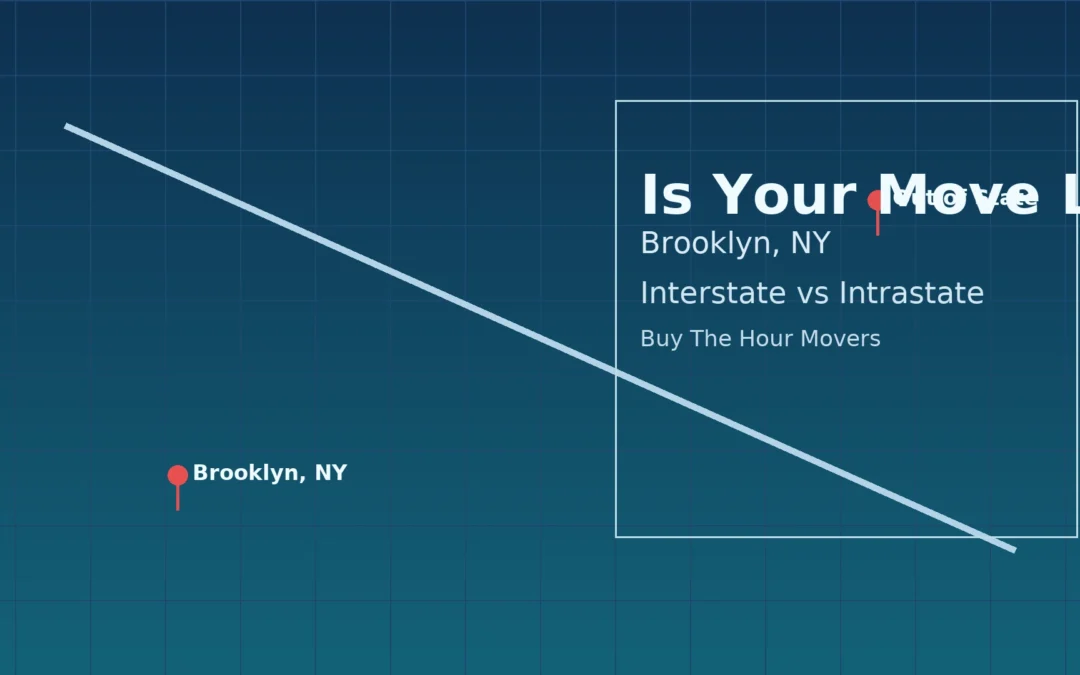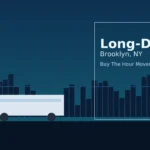Not sure if your move qualifies as long distance, start with a quick survey from Buy The Hour Movers. Our long distance movers in Brooklyn explain mileage thresholds, interstate rules, and how those details change your quote and delivery plan.
What is considered long distance for a moving company?
There is no single national definition that all movers use. In practice, pricing and planning depend on two realities that work together. First, whether your shipment crosses a state line. Second, the miles between origin and destination. Many carriers use approximate ranges to sort jobs for staffing and truck type, for example 0 to 50 miles as local, 50 to 150 miles as regional, and greater distances as long distance. Your legal protections and paperwork change once a move is interstate, which brings Federal Motor Carrier Safety Administration rules into play. Review FMCSA consumer guidance here, Protect Your Move and the official Rights and Responsibilities When You Move.
Key takeaways
- Crossing a state line makes the shipment interstate, interstate shipments follow federal household goods rules.
- Distance matters for truck type, crew scheduling, and transit time windows.
- Your estimate should be in writing and list transportation and accessorial charges, see FMCSA guidance on Estimating Charges.
Is 100 miles considered a long distance move?
The 100 mile number is a common planning threshold, not a law. Some carriers treat under 100 miles as local or regional, others set different limits. For you as a consumer, the more important line is interstate status, not a round number. A 90 mile move from Brooklyn to New Jersey is interstate, a 140 mile move from Brooklyn to Albany is intrastate. Both can be long distance in planning terms, only one is interstate in a legal sense. If the crew will cross a state border, expect federal paperwork, valuation choices, and delivery window rules. Read the FMCSA booklet above and use the mover lookup to confirm licensing, Household Goods Mover Search.
What counts as an interstate move?
Your shipment is interstate when goods travel from a place in one state to a place in another state. The interstate status triggers federal consumer protections, including how estimates work and when additional charges can be collected. Learn how binding and non binding estimates differ in FMCSA’s consumer page on binding estimates and the policy section on Estimating Charges.
Paperwork you should expect on interstate moves
- A written estimate, binding or non binding, that lists transportation and accessorial charges.
- The FMCSA booklet, Your Rights and Responsibilities When You Move.
- A bill of lading with valuation terms and a pickup and delivery window.
- Scale tickets for weight based pricing on interstate shipments.

What is the difference between local and long distance moves?
Local usually involves one day, one crew, and a small to medium truck. Charges often use hourly rates plus materials. Long distance uses a line haul rate based on weight and miles, written inventories, and a delivery window. Intrastate long distance follows state rules, interstate long distance follows federal rules. In New York, intrastate household goods movers follow state guidance from NYSDOT, see the state’s overview for household goods carriers here, NYSDOT Household Goods. For city logistics, plan around NYC rules for truck routing and parking, see NYC DOT Truck Routing.
Planning differences that affect your price and schedule
- Transport model: dedicated truck for your shipment or consolidated route with other shipments.
- Access conditions: elevator reservations, stair flights, long carry from curb to elevator, certificate of insurance for buildings in Brooklyn or Manhattan.
- Valuation coverage: released value is minimal, full value protection costs more and raises protection limits.
- Date options: mid week and mid month dates can improve availability.
Do long distance moves have a minimum distance?
Carriers often set minimum weights rather than a minimum distance. If your shipment weighs below that minimum, pricing rounds up to the tariff minimum. This protects the capacity of long haul trucks and crews. Ask your estimator to explain any minimum weights and how they apply to your inventory. The estimator should clarify whether your plan is a dedicated truck or a consolidated route, and the delivery window that applies under that plan.
How thresholds influence your quote
- Miles influence fuel, driver hours, and tolls.
- Weight drives line haul charges on interstate shipments.
- Accessorial items like packing, crating, shuttle, and storage in transit add to the total.
- Delivery model changes timing and sometimes price. Dedicated service tightens dates, consolidated service spreads risk and lowers per pound rates.
Brooklyn specifics that shape definitions and logistics
Brooklyn blocks, bridge approaches, and loading rules reward tight planning. Commercial vehicles must follow legal truck routes, and many buildings require a certificate of insurance for the move date. Use NYC’s official map and guidance, NYC DOT Truck Route Map and the page on commercial vehicle parking. Share your building rules with your estimator so crew size, truck size, and window reservations match the plan.
Checklist for a clear definition and clean quote
- Confirm origin and destination states, that sets interstate or intrastate status.
- Share the full room by room inventory with photos.
- Identify stairs, elevator size, and the walking distance from curb to elevator.
- Reserve elevator and loading dock windows in writing.
- Ask for a written estimate that is either binding or not to exceed, plus valuation details.
- Verify active licensing for interstate moves in the FMCSA lookup, HHG Mover Search.
FAQ
Is 100 miles a hard rule for long distance
No, it is a planning guideline used by some movers. Interstate status and miles together drive the service model and the estimate.
Can a move inside New York still be long distance
Yes, if the miles are high. A long intrastate move follows state rules, and may still take a multi day delivery window.
How do I know if my estimate is binding
Your paperwork will state binding or non binding in the estimate header. Read FMCSA’s page about binding estimates.
Do interstate movers always charge by weight
Interstate tariff pricing uses weight and miles. If a mover proposes volume pricing, ask for the conversion to weight in writing and keep the scale tickets.
What documents should I receive before pickup
A written estimate, the FMCSA booklet, and your bill of lading with scheduled windows and valuation terms.
Work with a Brooklyn team that knows the rules
Buy The Hour Movers is based in Brooklyn, NY and handles interstate and long intrastate relocations with clean paperwork and predictable delivery plans. Start with a quick survey and a written estimate.
- Request your quote: Brooklyn Long Distance Movers
- Contact our team: Contact Us
Serving nearby neighborhoods and boroughs
Williamsburg, DUMBO, Park Slope, Brooklyn Heights, Bushwick, Greenpoint, Fort Greene, Carroll Gardens, Cobble Hill, Crown Heights, Prospect Heights, Bay Ridge, Sunset Park, moves connecting to Manhattan, Queens, The Bronx, and Staten Island.







